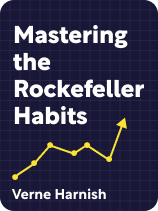

This article is an excerpt from the Shortform book guide to "Mastering the Rockefeller Habits" by Verne Harnish. Shortform has the world's best summaries and analyses of books you should be reading.
Like this article? Sign up for a free trial here.
What makes the difference between productive meetings and time-wasting gatherings? How can daily and weekly check-ins transform your company’s success?
Getting the structure and frequency of meetings just right is crucial for business growth. In Mastering the Rockefeller Habits, Verne Harnish outlines specific formats for daily and weekly team gatherings that can help make every minute count.
Read on to discover how to turn your company meetings from draining to energizing.
Focused Daily and Weekly Meetings
The final Rockefeller Habit is Conducting Effective Meetings. Harnish reveals the optimal format and frequency of meetings that can make a positive difference for your company’s culture and bottom line.
While many companies see meetings as recurring drains of time and productivity, Harnish asserts that frequent meetings greatly accelerate your progress—as long as you run them the right way. Every meeting should have a predefined agenda and a strict time limit to ensure it’s not wasting anybody’s time.
(Shortform note: Research confirms that many companies view meetings unfavorably. In one survey of 182 senior managers, 72% agreed that “meetings are unproductive and inefficient.” Harnish’s solutions (a strict agenda and time limit) resolve meeting participants’ most common complaints: that meetings are unfocused and take too long. However, many leaders fail to implement these simple improvements. Why? According to research, when someone leads a meeting, they view it as significantly more productive than other participants view it. Thus, the people in charge don’t realize how important it is to gather employee feedback and optimize their agenda.)
Harnish says that most companies already run effective quarterly and annual meetings in which they brainstorm major goals and how to achieve them. However, many of those companies neglect effective daily and weekly meetings, which Harnish asserts are just as necessary to accomplish your mission.
(Shortform note: Although Harnish contends that the most effective companies should meet every day, some have found success taking the opposite approach. One study found that when companies banned meetings for three out of five days a week, their employees’ productivity rose by an average of 73%. These researchers found that banning more meetings didn’t yield further benefits. Weekly meetings were still useful for two main reasons: They gave employees the chance to coordinate their weekly schedules and maintain social connections.)
| How Amazon Runs Major Strategy Meetings In Working Backwards, Colin Bryar and Bill Carr explain how to optimally run the kind of big-picture strategy meetings that companies might conduct quarterly or yearly. These authors contend that executives create the best strategies when they can build off the ideas of executives at different management levels. Amazon demonstrates this in their twice-annual planning process: First, the top executives put forward big-picture company goals. Then, lower-level managers propose strategies and projects that would help them reach those goals. Finally, top executives select which of those strategies and projects the teams below them should prioritize. |
Daily Meetings
According to Harnish, everyone in the company needs to attend a meeting every day for five to 15 minutes. They don’t have to meet with the whole organization, but they at least need to meet with their most relevant coworkers. In these meetings, they can clarify what problems need to be solved today and ensure that everyone has the information they need to solve them.
To this end, Harnish contends that daily meetings should follow a three-item agenda: First, each team member quickly sums up what they’re doing today. Giving everyone a basic awareness of what their coworkers are doing helps coordinate collaboration and clear up any conflicts.
Second, the team reviews the latest daily Profitability Indicators. Staying continuously aware of these metrics helps everyone adapt their strategies to sudden changes.
Last, anyone who has an obstacle preventing them from making progress announces it to the rest of the team. Harnish asserts that this is the most important part of the meeting because it focuses everyone’s attention on the most productive kind of work: resolving blockages that prevent people from working optimally.
| Daily Meetings: Scrum vs. Kanban Many refer to these daily alignment meetings as “stand-up” meetings because it’s easier to stick to a strict time limit of 15 minutes when participants are forced to stand up for the whole meeting rather than sit. The two most popular types of stand-ups are those used in project management methodologies called Scrum and Kanban. Harnish’s daily meetings have more in common with Scrum stand-ups, which also involve asking each participant what they intend to get done today and what obstacles they have blocking their progress. The main reason not to call Harnish’s framework a variation of Scrum is because it doesn’t involve sprints. Teams using Scrum divide their working year into sprints that typically last two to four weeks. By the end of each sprint, they must produce a finished product of some kind. This ensures that the team is always delivering results, even if those results are incremental. Kanban stand-ups revolve around a Kanban board, a visual display of a team’s workflow. Basic Kanban boards consist of three columns labeled “to-do,” “in progress,” and “done.” The team creates a notecard to represent each task they need to complete. Then, they move it from one column to the next as work gets done. This allows everyone to see, at a glance, the status of all the team’s tasks. In Kanban stand-ups, this removes the need for every participant to give a full report of their work. Instead, the team can use the meeting to identify and resolve issues or blockages in the workflow that the Kanban board reveals (for instance, if one column in the workflow was overloaded with task cards). Harnish’s daily meeting agenda is unique in recommending that teams review Profitability Indicators every day. Arguably, this big-picture perspective on the company’s health makes his framework more useful for meetings in which leaders make strategic decisions, and less useful within traditionally project-centered methodologies like Scrum and Kanban. |
Weekly Meetings
Next, Harnish argues that everyone in the company should meet with relevant coworkers every week for 30 to 60 minutes. As in daily meetings, weekly meetings should follow a specific agenda.
Item #1: Celebrate
First, team members share any good news that’s happened to them recently, whether at work or in their personal lives. According to Harnish, this will boost everyone’s mood, setting the stage for a productive meeting.
Item #2: Review Suggestions for Improvement
Second, the team reviews suggestions from employees or customers regarding how the business could improve. Harnish suggests picking a recurring problem and assigning someone to investigate and try to solve it in the upcoming week. Even if you’re only able to solve a tiny problem each week, if your solution lasts, those improvements are cumulative. For instance, if a coding team complains that an automated email list bombards them with messages that aren’t relevant to them, you could assign someone to take their team off the company-wide email list. Fix enough little problems like this, and you’ll have radically transformed your company.
To learn what recurring problems are hurting your business, Harnish recommends sending out surveys to every employee asking what the company could be doing better for them—and for customers. Then, set up a system that allows employees to submit feedback at any time, and encourage them to do so for every issue they encounter, no matter how small. Do the same for your customers. This way, you’ll always have feedback to review and act upon in every weekly meeting.
Item #3: Review Profitability Indicators
Next, Harnish explains that the team reviews more detailed Profitability Indicators than those you review in daily meetings. In particular, gauge how much progress you’ve made toward the company’s quarterly goals. As in daily meetings, this big-picture awareness of the company will help people set smarter strategies as they work.
Item #4: Strategize About Weekly Goals
Last, Harnish advises the team to use the bulk of the meeting to discuss strategy. Specifically, identify a narrow subgoal that will help you achieve your themed quarterly target, and open the floor for suggestions on how to accomplish it. For example, if your quarterly goal is to lower your manufacturing costs by 30%, at one weekly meeting you could brainstorm ways to reduce your transportation expenses. Limit yourself to discussing a narrow subtopic like this each week to give yourself the dedicated time needed to dive deeply into the topic at hand.

———End of Preview———
Like what you just read? Read the rest of the world's best book summary and analysis of Verne Harnish's "Mastering the Rockefeller Habits" at Shortform.
Here's what you'll find in our full Mastering the Rockefeller Habits summary:
- What an oil tycoon can teach you about business
- How knowing your business’s unique value is key to beating the competition
- Why you should create fun themes for your quarterly goals






